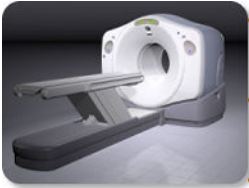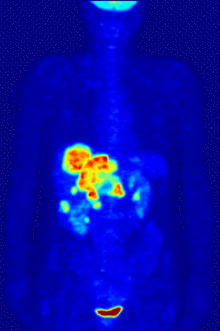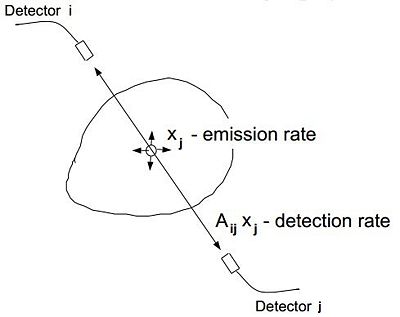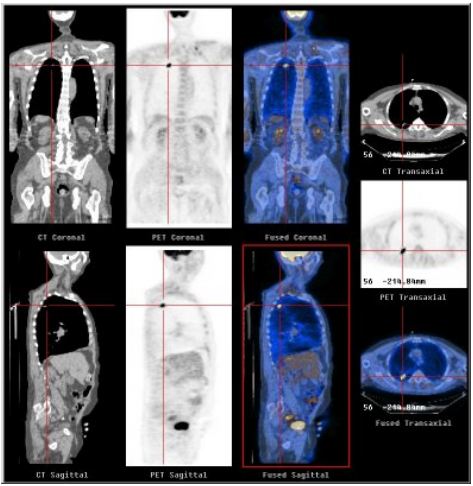The Bouman Lectures on Image Processing
A sLecture by Maliha Hossain
Subtopic 3: Positron Emission Tomography
© 2013
Excerpt from Prof. Bouman's Lecture
Accompanying Lecture Notes
Positron Emission Tomography, or PET, is a non invasive imaging technique that produces a three-dimensional representation of the body. It is commonly used in clinical oncology and is a functional medical imaging modality. It can also be used as a form of molecular imaging.
Figure 1 shows a PET scanner. It is very similar to a CT scanner in appearance but the process in which measurements are taken by a PET scanner is completely different.
Prior to a PET a scan, the patient is injected with a positron emitting radio-tracer, typically Fluorodeoxyglucose (FDG). FDG is a glucose molecule where the fluorine atom is the radioactive isotope $ ^{18} $F sugar with a fluorine atom attached. $ ^{18} $F has a half-life of about 110 minutes. This is long enough for it to be produced in a cyclotron, combined with the sugar and transported to the hospital and still be detectable after the sugar has been injected. Since an atom's chemical behavior is largely determined by its electronic structure, different isotopes exhibit nearly identical chemical behavior. The body therefore metabolizes FDG like other as sugars. Cancerous cells metabolize more sugar at a higher rate because they tend to grow uncontrollably. A tumor will have a higher rate of uptake of the FDG than the surrounding healthy tissue and it will light up in the scan. The bladder and kidneys will also light up since they regulate and excrete sugars.
As the FDG in patients body is metabolized, the radioactive isotope may break down. when it breaks down, simplified, it releases a positron which annihilates a nearby electron. As a result of this annihilation, two gamma particles are released. the momentum of the two gamma particles are not exatly zero because the positron had some momentum before it collided with the electron. the angle is approximately 179 degrees. so you have two gamma particles travelling at almost exactly opposite directions. the PET contains a ring of detectors (this ring is stationary whereas the detectors in a CT scanne rotate with the gantry). Each detector in a PET scanner counts photons. when it encounters photon. it registers the time of the photon. a photon travels about a foot (30 cm to be exact) in free space in a ns. if two detectors that are across from each other detect a scintillation within at the same time or very close to each other (within a small margin of time) it is assumed that those two photons were produced from the same annihilation.
So for example, let $ t_i $ and $ t_j $ be the time when detectors i and j in figure 3 register a scintillation. Since the cavity in the scanner is a few feet across, then we can assume that if $ |t_i-t_j| < 10 $ ns, the gamma particles detected resulted from the same annihilation. they are from the same coincident event.
given that you have 512 detectors, you have 512(511)/2 virtual detectors. because that's all the unique paors of detectors that you have. for every unique pair of detector, you have a virtual detector and you cound how many annihilation uccur along that detector and you get a line integral. so this is another techonology where you obtain a line integral. once you have obtiined it, it boils down to the same inversion process. but the underlying physics of the acquisition are quite different.
figure for positron electron annihilation
$ E[y_i] = \sum_j A_{ij}x_j \ $
PET scanners are much more expensive than CT scanners. They also have poor spatial and temporal resolution. Most PET systems are equipped with a CT scanner like the one shown in figure 1. Figure 4 shows a PET scan superimposed on a CT scan. This is much more helpful to radiologists trying to diagnose diseases. You can see that there is very little anatomical detail in the stand alone PET scans in figures 2 and 4.





